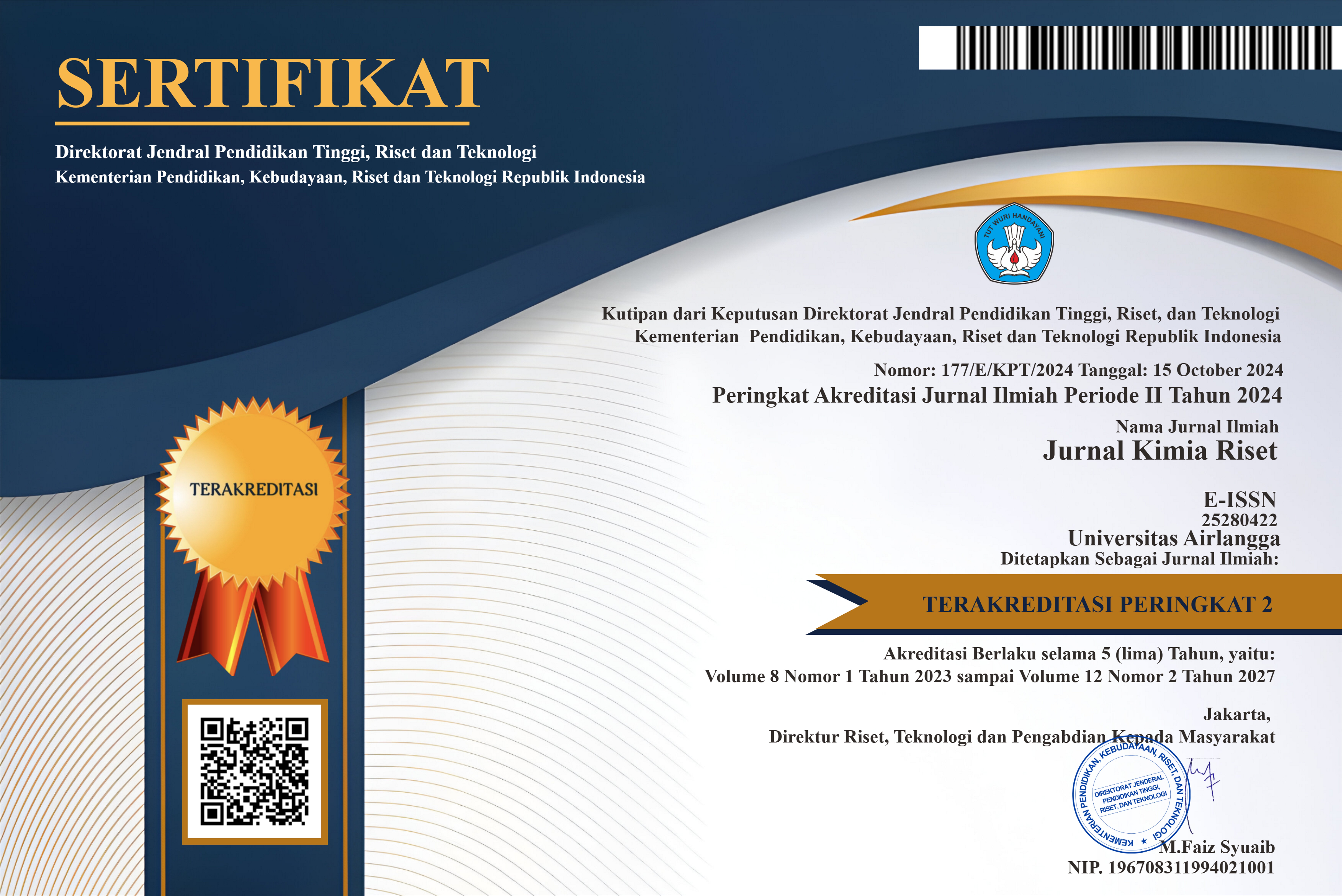MOLECULAR DOCKING STUDY OF EPIGALLOCATECHIN GALLATE (EGCG) AS A THERAPY FOR TYPE 2 DIABETES MELLITUS
Downloads
Epigallocatechin gallate (EGCG) has an effect in reducing sugar levels in the blood by inhibiting α-glucosidase enzyme, which is connected explicitly by hydrogen bonds and modifies the secondary structure and micro-environment of the enzyme reversibly and non-competitive. This study looks at the activity and interaction of EGCG as α-glucosidase inhibitors in the form of binding affinity and compound bonding profiles with receptors, including toxicity predictions and drug-likeness results. The research was performed in silico with molecular docking on Autodock Vina that integrated through PyRx, then viewed the compound's binding profile with receptor using Discovery Studio 2021 Client, toxicity prediction using ProTox-II and determination of drug-likeness using SwissADME based on Lipinski's rule of five guidelines. The control drugs used were acarbose and miglitol. The molecular docking results obtained that the binding affinity of EGCG is -8.4 kcal/mol while acarbose and miglitol are -13.8 kcal/mol and -5.3 kcal/mol respectively. There are amino acid residues similar to the drug control with various interactions like electrostatic, hydrophobic, and hydrogen bonds; then it has an inactive target for each toxicity parameter and has a molecular weight of 458.37 g/mol; Log P value of 1.01; H-bond donor of 8; and H-bond acceptor of 11 in the determination of drug-likeness. Based on these results, EGCG has effectiveness as α-glucosidase inhibitors predicted to be non-toxic; however, there are violations in determining drug-likeness.
Aissouq, A. El, Chedadi, O., Bouachrine, M. and Ouammou, A., 2021. Identification of novel SARS-CoV-2 inhibitors: a structure-based virtual screening approach. Journal of Chemistry, 2021.
Banerjee, P., Eckert, A.O., Schrey, A.K. and Preissner, R., 2018. ProTox-II: a webserver for the prediction of toxicity of chemicals. Nucleic Acids Research, 46, W257–W263.
Baynest, H.W., 2015. Classification, pathophysiology, diagnosis and management of diabetes mellitus. Journal of Diabetes & Metabolism, 6(5), 1–9.
BIOVIA, 2021 Discovery Studio Client 2021, v21.1.0.20298, San Diego: Dassault Systèmes.
Budiarto, D., Wijianto, B. and IH, H., 2023. Study of anthocyanin molecule blocking as anti-hypertensive through the pathway of the Renin-Angiotensin-Aldosterone System (RAAS). J. Chem. Res, 11(1), 49–58.
Daina, A., Michielin, O. and Zoete, V., 2017. SwissADME: A free web tool to evaluate pharmacokinetics, drug-likeness and medicinal chemistry friendliness of small molecules. Scientific Reports, 7(42717), 1–13.
Dallakyan, S. and Olson, A.J., 2015. Small-molecule library screening by docking with PyRx. Methods in Molecular Biology, 1263, 243–250.
Derosa, G. and Maffioli, P., 2012. α-Glucosidase inhibitors and their use in clinical practice. Archives of Medical Science. 8(5), 899–906.
DiPiro, J.T., Yee, G.C., Posey, L.M., Haines, S.T., Nolin, T.D. and Ellingrod, V., 2020. Pharmacotherapy a pathophysiologic approach. Eleventh. United States: McGraw-Hill Education.
Dirir, A.M., Daou, M., Yousef, A.F. and Yousef, L.F., 2022. A review of alpha-glucosidase inhibitors from plants as potential candidates for the treatment of type-2 diabetes. Phytochemistry Reviews, 21(4), 1049–1079.
Dyas, R.A.A., Wijianto, B. and IH, H., 2023. Docking studies for screening antibacterial compounds of Red Jeringau (Acorus calamus L.) using Shigella flexneri protein as a model system. Acta Chimica Asiana, 6(2), 343–350.
El-Din, H.M.A., Loutfy, S.A., Fathy, N., Elberry, M.H., Mayla, A.M., Kassem, S. and Naqvi, A., 2016. Molecular docking based screening of compounds against VP40 from Ebola virus. Bioinformation. 12(3), 192–196.
Ferwadi, S., Gunawan, R. and Astuti, W., 2017. Studi docking molekular senyawa asam sinamat dan derivatnya sebagai inhibitor protein 1J4X pada sel kanker serviks. Jurnal Kimia Mulawarman, 14(2), 84–90.
Furniturewalla, A. and Barve, K., 2022. Approaches to overcome bioavailability inconsistencies of epigallocatechin gallate, a powerful anti-oxidant in green tea. Food Chemistry Advances, 1, 1–7.
Galicia-Garcia, U., Benito-Vicente, A., Jebari, S., Larrea-Sebal, A., Siddiqi, H., Uribe, K.B., Ostolaza, H. and Martín, C., 2020. Pathophysiology of type 2 diabetes mellitus. International Journal of Molecular Sciences, 21(17), 1–34.
Gupta, R., Polaka, S., Rajpoot, K., Tekade, M., Sharma, M.C. and Tekade, R.K., 2022. Chapter 6 - Importance of toxicity testing in drug discovery and research', in R.K. Tekade (ed.) Pharmacokinetics and Toxicokinetic Considerations. Academic Press (Advances in Pharmaceutical Product Development and Research), 117–144.
Habtemariam, S.. 2019. Current pharmacotherapy options for type 2 diabetes, in Medicinal Foods as Potential Therapies for Type-2 Diabetes and Associated Diseases. Elsevier, 89–107.
Hossain, U., Das, A.K., Ghosh, S. and Sil, P.C., 2020. An overview on the role of bioactive α-glucosidase inhibitors in ameliorating diabetic complications. Food and Chemical Toxicology, 145, 1–16.
International Diabetes Federation. 2021. International diabetic federation diabetic atlas 10th edition.
Irawan, D., Wijianto, B. and Ih, H., 2023. Study molecules docking of alkaloids in kratom on Serotonin Transporter (SERT), Norepinephrine Transporter (NET), and Monoamine Oxidase (MAO). Jurnal Kimia Riset, 8(2), 200–219.
Kumar, S. and Pandey, A.K., 2013. Chemistry and biological activities of flavonoids: An overview. The Scientific World Journal, 2013, 1–16.
Kumar, Y., Goyal, R.K. and Thakur, A.K., 2018. Pharmacotherapeutics of miglitol: an α-glucosidase inhibitor', Journal of Analytical & Pharmaceutical Research, 7(6), 617–619.
Kurniawan, M.A.S., Baari, M.J., Sariyanti and Finarisnawati, 2023. QSAR analysis using semi-empirical am1 method, molecular docking, and admet studies of chalcone derivatives as antimalarial compounds. Jurnal Kimia Riset, 8(2), 186–199.
Lestari, Zulkarnain and Sijid, ST.A., 2021. Diabetes melitus: review etiologi, gejala, penyebab, cara pemeriksaan, cara pengobatan dan cara pencegahan. Prosiding Biologi Achieving the Sustainable Development Goals with Biodiversity in Confronting Climate Change, 7(1), 237–241.
Lipinski, C.A., 2004. Lead- and drug-like compounds: The rule-of-five revolution. Drug Discovery Today: Technologies, 1(4), 337–341.
Liu, S.-K., Hao, H., Bian, Y., Ge, Y.-X., Lu, S., Xie, H.-X., Wang, K.-M., Tao, H., Yuan, C., Zhang, Juan, Zhang, Jie, Jiang, C.-S. and Zhu, K., 2021. Discovery of new α-Glucosidase inhibitors: structure-based virtual screening and biological evaluation. Frontiers in Chemistry, 9(639279), 1–9.
Morris, G.M., Ruth, H., Lindstrom, W., Sanner, M.F., Belew, R.K., Goodsell, D.S. and Olson, A.J., 2009. Software news and updates AutoDock4 and AutoDockTools4: automated docking with selective receptor flexibility. Journal of Computational Chemistry, 30(16), 2785–2791.
Nguyen, T.T.H., Jung, S.H., Lee, S., Ryu, H.J., Kang, H.K., Moon, Y.H., Kim, Y.M., Kimura, A. and Kim, D., 2012. Inhibitory effects of epigallocatechin gallate and its glucoside on the human intestinal maltase inhibition. Biotechnology and Bioprocess Engineering, 17(5), 966–971.
Perumal, P., Parasuraman, P., Mani, V. and Azahan, N.S.M., 2017. Anticholinesterase activity of dipeptides: in-silico docking and in-vitro studies. Inventi Rapid: Molecular Modelling, 2017(2), 1–4.
Rena, S.R., Nurhidayah, N. and Rustan, R., 2022. Analisis molecular docking senyawa Garcinia mangostana L sebagai kandidat anti SARS-CoV-2. Jurnal Fisika Unand, 11(1), 82–88.
Sari, I.W., Junaidin, J. and Pratiwi, D., 2020. Studi molecular docking senyawa flavonoid herba kumis kucing (Orthosiphon stamineus B.) pada reseptor α-glukosidase sebagai antidiabetes tipe 2. Jurnal Farmagazine, 7(2), 54–60.
Schmeltz, L. and Metzger, B., 2007. 6.19 - Diabetes/Syndrome X, in J.B. Taylor and D.J. Triggle (eds) Comprehensive Medicinal Chemistry II. Oxford: Elsevier, 417–458.
Shah, K., Mujwar, S., Gupta, J.K., Shrivastava, S.K. and Mishra, P., 2019. Molecular docking and in silico cogitation validate mefenamic acid prodrugs as human cyclooxygenase-2 inhibitor. Assay and Drug Development Technologies, 17(6), 285–291.
Sim, L., Quezada-Calvillo, R., Sterchi, E.E., Nichols, B.L. and Rose, D.R., 2008. Human intestinal maltase-glucoamylase: crystal structure of the N-terminal catalytic subunit and basis of inhibition and substrate specificity. Journal of Molecular Biology, 375(3), 782–792.
Suharyani, I., Falya, Y., Hakim, A.N., Fajira, D. Al, Sadira, N.A.A. and Astuti, S.Y., 2022. Review artikel: potensi senyawa aktif pada tanaman obat untuk penanganan COVID-19 dengan metode molecular docking. Medical Sains, 6(2), 115–122.
Sukmawaty, E., Susanti, S. and Masriany, M., 2021. Penambatan molekuler senyawa cendawan endofit Trichoderma sp. sebagai inhibitor protein low density lipoprotein, enzim lanasterol 14-A demetilase dan lipase yang bertanggung jawab dalam dermatitis seboroik. Jurnal Ilmiah Ibnu Sina (JIIS): Ilmu Farmasi dan Kesehatan, 6(1), 98–107.
Susanti, N.M.P., Laksmiani, N.P.L., Noviyanti, N.K.M., Arianti, K.M. and Duantara, I.K., 2019. Molecular docking terpinen-4-ol sebagai antiinflamasi pada aterosklerosis secara in silico. Jurnal Kimia (Journal of Chemistry), 13(2), 221–228.
Syahputra, G., Ambarsari, L. and Sumaryada, T., 2014. Simulasi docking kurkumin enol, bisdemetoksikurkumin dan analognya sebagai inhibitor enzim 12-lipoksigenase. Jurnal Biofisika, 10(2), 55–67.
Wen, L., Wu, D., Tan, X., Zhong, M., Xing, J., Li, W., Li, D. and Cao, F., 2022. The role of catechins in regulating diabetes: an update review. Nutrients, 14(21), 1–19.
Wijianto, B., Ritmaleni, Purnomo, H. and Nurrochmad, A., 2020. Curcumin mono-carbonyl analogs as potent antibacterial compounds: Synthesis, biological evaluation and docking simulation study', Rasayan Journal of Chemistry, 13(2), 1153–1165.
Wijianto, Bambang, Ritmaleni, Purnomo, H. and Nurrochmad, A., 2020. Quantitative structure activity relationship (QSAR) study and biological evaluation on mono-ketone analogs of curcumin as antioxidant. Research Journal of Pharmacy and Technology, 13(10), 4829–4835.
Wijianto, Bambang, Ritmaleni, R., Purnomo, H. and Nurrochmad, A., 2020. In silico and in vitro anti-inflammatory evaluation of 2,6-bis-(3'-ethoxy, 4'-hydroxybenzylidene)-cyclohexanone, 2,6-bis-(3'-Bromo,4'-methoxybenzylidene)-cyclohexanone, and 2,6-bis-(3',4'-dimethoxybenzylidene)-cyclohexanone. Journal of Applied Pharmaceutical Science, 10(6), 99–106.
Yuniarto, A. and Selifiana, N., 2018. Aktivitas Inhibisi Enzim Alfa-glukosidase dari Ekstrak Rimpang Bangle (Zingiber cassumunar Roxb.) secara In vitro. Media Pharmaceutica Indonesiana, 2(1), 22–25.
Copyright (c) 2024 Jurnal Kimia Riset

This work is licensed under a Creative Commons Attribution-NonCommercial-ShareAlike 4.0 International License.
COPYRIGHT NOTICE
1. By submitting the article to Jurnal Kimia Riset (JKR), the author has agreed to transfer some of the copyrights to the publisher of the research chemistry journal, Universitas Airlangga, indicated in the Copyright Transfer Agreement.
2. Authors still retain significant rights to use and share their own published articles for non-commercial purposes subject to Creative Commons Attribution-NonComercial 4.0 International License
3. All publications (printed/electronic) are open access for educational purposes, research, library, and other non-commercial purposes. Besides the purposes mentioned above, the editorial board is not responsible for copyright violations.















